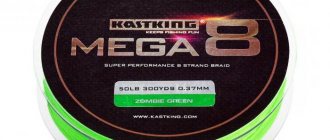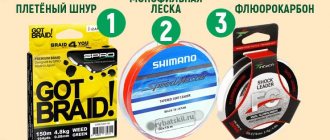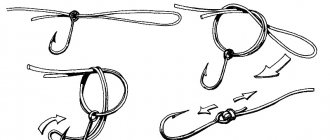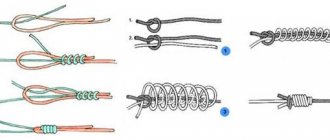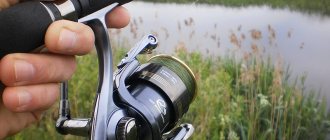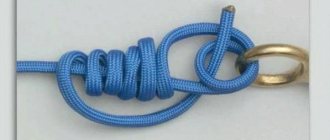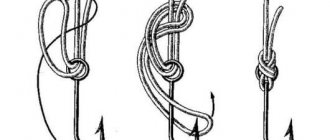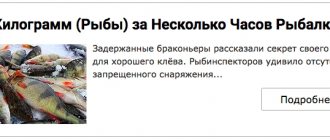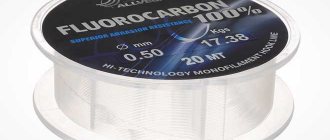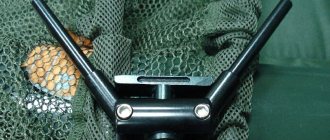Why do you need a shock leader in a snap-in?
This does not mean at all that trophy fish are caught only from distant points, because at night and in the morning they come to the shore to feast on insects falling from the branches of trees and bushes. But general trends indicate that fishing at long ranges is more effective, and anglers choose equipment that facilitates comfortable long-distance casting of gear.
To perform long throws you need:
- powerful rod;
- thin fishing line;
- balanced equipment.
If everything is clear with the rod and equipment, then choosing a fishing line for long-distance fishing presents a certain difficulty, because it must be thin, but also strong, capable of withstanding serious overloads during casting with a powerful blank.
The optimal line diameter for carp gear is considered to be 0.22–0.25 mm, and every extra millimeter of thickness “steals” several meters of distance when casting hard. Manufacturers of fishing equipment and fishing lines in particular are constantly improving their products, improving their quality and increasing strength.
But still, this is not enough to be sure that a fishing line with a diameter of 0.22 mm will withstand overloads when casting, of which there are many in fishing, and the “fatigue” of the material does not add reliability to the equipment.
A solution to the problem was found by fans of surf casting, and they were the first to use shock leaders to prevent equipment breaks during power casting.
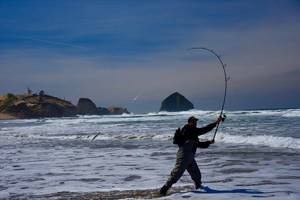
These leaders are now using:
- carp fishermen;
- fans of feeder fishing;
- spinners;
- floaters when fishing with match gear.
The name shock leader itself speaks volumes about the purpose of this equipment component, designed to compensate for loads during peak periods, during casting and in the last meters when fishing for a trophy.
Advantages
The main advantages of the shock leader include the ability to cast large masses of equipment, reliable supply to the shore and planting large specimens of caught fish in landing nets, and fishing with thin main lines, which makes the tackle more sensitive to bites and control of bait when fishing. An important advantage is the resistance to abrasion on the shell and rocky bottom of the equipment with the addition of monofilament shocks to the braided bases. In addition, the use of this addition saves cord, transferring only a segment of the shock into the category of consumables on which rigs are knitted, changing new fishing sessions to suit the required conditions. Casting a tackle using a shock leader is much safer in terms of injuring your fingers. After all, thicker diameter wood does not cut the skin when controlling the moment of supply of equipment.
What are the requirements for a shock leader?
The shock leader is knitted in order to:
- take on extra loads when casting;
- compensate for the force pressure on the thin main line;
- save the main line when fishing on a difficult bottom, with shells and debris;
- additionally disguise the equipment;
- compensate for the jerks of large fish when introduced into the landing net.
The strength of the shock leader is determined, among other things, by the weight of the equipment being thrown and the thickness of the main fishing line, so there is no strict recommendation regarding the choice of this element of equipment.
Even if we take into account that the feeder rod has a flexible whip (quivertip) and when casting, the load on the main line is less, when fishing at long ranges, feeders also use shock leaders made of durable braided line.
Important!!! The strength of the shock leader is always higher than the strength of the main line.
What is a shock leader: definition and concept
This is the name given to a piece of strong fishing line, the length of which is approximately 2 times the length of the fishing rod. This section should be stronger than the main line. During casting, the leader takes on the entire load and reduces the risk of breakage. A thin line allows the angler to cast over long distances, but during casting it is highly likely to fail to withstand the load and burst. The combination of a leader and a thinner main line allows you to make long casts without loss.
The leader is used for all types of fishing, where the equipment is cast a long distance from the shore. It is used by spinning anglers, feeders and carp fishing enthusiasts.
Reinforced fishing line will help prevent gear breakage if a false cast occurs with the spool closed on the reel. In addition, it will help avoid cuts on your finger. Thin fishing line can injure your finger while casting.
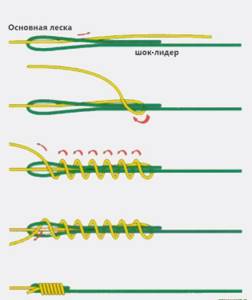
A large fish that is brought to the shore and tried to be picked up begins to resist strongly. In this case, you will need a leader who can withstand strong jerks. And if the bottom of the reservoir is strewn with stones and shells, the thin fishing line may become damaged and burst. The leader is resistant to such damage because it does not wear out as quickly.
What are shock leaders?
Materials for making shocks are:
- small diameter braided cord;
- a piece of thick monofilament;
- a piece of fluorocarbon fishing line.
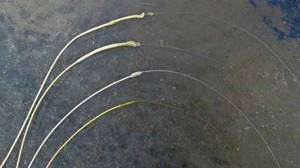
The market also offers ready-made shock leaders made from conical monofilament, which have high strength and minimal elongation. The following combinations of base and shock leader are possible:
- monofilament base – shock braided cord;
- base braided cord - shock thick monofilament;
- the base cord is a shock cord of greater strength;
- monofilament base – shock is also monofilament, but thicker than the base.
Which knot should I use to tie the shock leader to the feeder?
For the most correct use of the knot when tying the shock leader under the feeder, it is necessary to take into account the diameters of the connecting lines and their types.
At the same time, in order for the strength of the knot to be maximum and the additional load during casting to be minimal, several rules must be followed:
- Before tightening any knot, the ends of the fishing line must be wetted.
- After tightening the marking knot, both ends of the fishing line should be directed towards the base, but not perpendicular to it.
- After tightening the knot, the ends of the fishing line must be cut. This must be done very carefully.
- It is recommended to treat the finished assembly with waterproof glue, which makes it even smoother and more durable.
How to choose a shock for fishing
When choosing a shock leader for bottom fishing, focus on:
- fishing distance;
- features of the bottom of the reservoir;
- equipment weight.
Braided shock leader
Most often, a braided cord is used as a shock, which has high strength and reliability, especially compared to conventional fishing lines. The thickness of the cord is less than monofilament, but the same strength, which provides advantages when camouflaging equipment.
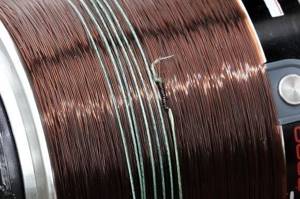
Feeder rigs are tied onto a braided shock leader and it is important that it is unnoticeable in the water. The braided cord does not stretch and with a powerful force cast of the tackle it retains its physical characteristics.
Thanks to the use of a braided shock, a thin main monofilament line creates minimal resistance in the water during the current and less sail when casting. But at the same time, the low stretchability of the braided cord does not allow it to dampen the jerks of the fish when playing, and this disadvantage is compensated for by using a shock made from stretchable monofilament.
Experienced fishermen recommend that when choosing braid for a shock leader, you should focus not on the diameter, but on the breaking load, because these parameters often differ between different manufacturers.
So, the advantages of a braided shock:
- high strength;
- effectiveness of use when fishing at a considerable distance;
- small diameter.
Disadvantages of braided shock:
- slight stretchability, which is important when fishing for trophies;
- the possibility of fish gathering near the shore;
- low abrasion resistance;
- high price.
Important!!! To make a shock, choose sinking braided cords marked Sinking on the reel. Cheap braided fishing line for a shock leader will fray, and its camouflage qualities will be significantly reduced.
Monofilament and fluorocarbon
The abrasive characteristics of the line are low, and when fishing on difficult bottoms, it is recommended to use a leader made of monofilament or fluorocarbon. It turns out that the base in the form of a braided cord is stretched in the water column, and that part of the equipment that comes into contact with the bottom, stones and bottom debris is abrasion-resistant, because this is one of the main advantages of fluorocarbon.
If the equipment gets caught on an obstacle at the bottom of the reservoir, a strong shock will ensure the safety of the equipment and only the leash tied from a thin fishing line will break. In addition to the fact that a monofilament shock has stretchability, it is also convenient for feeders because it glides better over the rings when casting.
On feeders, the guides are smaller than on carp rods, and this factor plays an important role, especially when performing power casting.
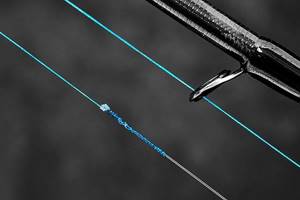
Colorless monofilament, and even more so fluorocarbon, have high camouflage characteristics and do not scare away fish from the feeder and hook with nozzle. Small fish are not too shy, but large trophies are much more cautious and distrustful of unusual objects, so when catching them, camouflage is important.
Another advantage of thick monofilament is that when casting forcefully, it does not cut the angler’s finger and a finger guard is not needed.
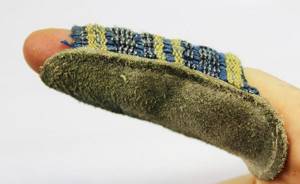
Advantages of a monoleader:
- availability of materials;
- low cost;
- smoothness, providing better “reach” of the equipment;
- high abrasion resistance;
- the ability to dampen fish jerks when fishing;
- convenience when casting gear.
Flaws:
- less strength than braided line - you need to take a thick fishing line;
- difficulty in binding;
- It is difficult to throw a tackle with a monoleader at an ultra-long distance;
- due to the thickness of the fishing line, the knot with the base turns out to be large and “hits” the rod rings when flying out.
Shock leaders made of fluorocarbon fishing line have virtually no disadvantages, they are invisible in the water, abrasion-resistant and have high strength and rigidity. But high-quality fluorocarbon materials are expensive and this is the reason why few anglers use them.
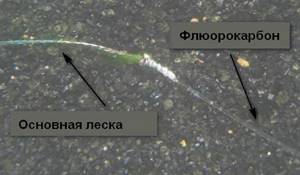
Important!!! It makes sense to use a monoleader when fishing at a distance of up to 120 meters.
European manufacturers, such as, for example, Preston, produce ready-made shock leaders that have advantages over monofilament and fluorocarbon. Ready-made shock leaders are made in the shape of a cone, and if in the place where the equipment will be tied, their thickness is 0.32 mm, then at the point of connection with the main fishing line, the diameter is already 0.20 mm.
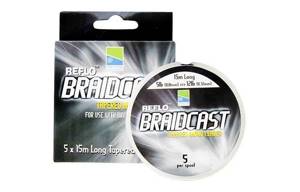
The conical shape of the shock contributes to better “flight” of the line when casting, and therefore to long-distance casts. The length of the finished shock is 15 m, this is enough to ensure safety when casting and reliability of the tackle.
Length
It is recommended to make a shock leader twice the length of the rod, but since in feeder fishing the rig is tied directly on the shock, it is necessary to make a reserve of 2-3 meters. If fishing is carried out with a rod 13 feet (3.9 meters) long, the shock is made 10-11, or even 12 meters. This length allows you to cut off a piece of the leader with the used equipment and not tie it up for the next fishing trip.
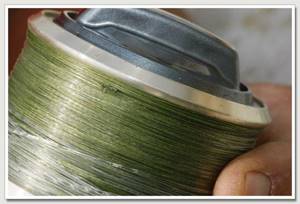
It turns out that several turns of the leader are wound on the reel spool, and it takes on the entire load when casting. When fishing, reeling the tackle to the shock leader, the angler must be more careful, but if a couple of turns of the shock are already wound on the reel, there is complete confidence that the fish will end up in the landing net.
Thickness and breaking load
As already mentioned, professionals focus on the breaking load, and not the thickness of the shock, and make their choice based on this criterion. Standard recommendations are for every ounce of load weight to provide 8-10 pounds of breaking load. For a load of 5 ounces, a shock of 40-50 Lb is chosen, but this is the case when ultra-long casts are expected. For regular fishing, shocks with a breaking load of 25-35 Lb (pounds) are used, and this is enough even for large fish.
Flaws
When using this technique when fishing with feeder rods, the angler should also pay attention to the possible significant disadvantages of the shock. First of all, these are problems with the junction of two sections, which is distinguished by a thickening in the form of a knot that prevents the casting and the cord from coming off the spool and the winding rings of the rod when casting. Tackle with a small diameter of rings does not accept knots for a shock leader, reducing the casting range and, if there are errors in its technique, can lead to a quiver tip break. No matter how miniature the knot may be, underwater debris will definitely hang up at the junction, affecting the windage of the tackle and requiring compensation for this shortcoming by increasing the mass of the cargo. An increase in the weight of the load entails a general loss of sensitivity of the gear and negatively affects control over the progress of the bite as a whole.
Knots for tying shock leader
The knot for tying the shock leader is made as small as possible, so that it slips freely in the rod guides when casting the tackle. Carp rods have larger rings than feeder rods, so the correct knot is especially important in feeder fishing.
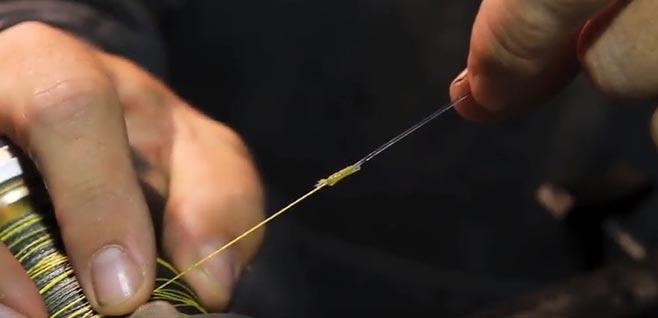
To knit a shock leader, it is recommended to use knots:
- carrot (Mahin knot);
- double grinner;
- Albright;
- bloody knot.
There are other knots used to knit leaders (for example, the Minenko knot), but the most common are those listed above. A novice fisherman should pay special attention to learning how to properly tie a shock leader to a fishing line, because comfort when casting and the safety of the equipment depend on this.
If the knot does not pass freely in the rings, a successful cast, especially over a long distance, will be difficult, if not impossible. Most often, pieces of old thick fishing line or laces are used for training, providing the necessary convenience.
Carrot knot for leader
The name of this knot is due to its external similarity to the famous vegetable, and the advantage is that both tails of the tied materials are directed in the direction opposite to the direction of throwing the tackle. When casting, such a knot does not cling to the rings and, thanks to its streamlined shape, freely skips through difficult areas. The correct carrot knot has a cone shape and small size, which is especially important in feeder fishing.
To make a carrot knot you need:
- make a regular knot on the shock leader;
- insert the warp into the knot formed with a margin of 30 cm;
- wrap the main fishing line around the shock leader, 10 turns in one direction and fixing the twist with your fingers, 10 in the other direction;
- thread the end of the fishing line into the shock leader knot;
- tighten the shock knot;
- moisten the twist and tighten it, holding both ends of the fishing line;
- trim the ends of the fishing line and shock;
- glue the knot with fishing glue.
The strength of the carrot knot is 100%, and it is considered the most reliable. Carrots are used for knitting any variants of warp and shock leader materials.
Double Grinner
To tie monofilament and braided fishing line, it is convenient to use a double-grinner knot, which is characterized by its small size and high strength. The difference in the thickness of the materials being bonded should be no more than 1/5.
To knit a double grinner you need:
- the materials are laid overlapping and ends 25-30 cm long are left;
- at the junction of the materials, a loop is made from one of them, which is clamped with your fingers;
- the free end of the loop is wrapped around both materials (5 turns);
- holding the ends, the knot is tightened;
- the same manipulations are performed with the second material;
- the knot is wetted and tightened;
- the resulting nodes are pulled together like a noose;
- the free ends are trimmed (1.5-2 mm remains).
Unlike the carrot, the double-grinner has the ends of the lines pointing in different directions and after numerous casts the knot becomes frayed. Therefore, it should be glued in order to ensure the necessary reliability.
Albright node
Albright is used by fly fishers, because this unit is compact and reliable; it binds materials with a difference in diameter of more than 1/3.
To make the Albright knot you need:
- a loop 10 cm long is formed from thicker material;
- thin material is threaded into the loop with a tolerance of 20 cm;
- at the point of intersection of the materials, they are pinched with your fingers, and the thin material is made 10 turns around the loop in the opposite direction;
- the end of the thin material is threaded through the loop again and tightened;
- excess ends are cut off (1.5-2 mm remains);
- the knot is glued.
Albright is the narrowest knot that fits freely into small rod rings, and is actively used in feeder fishing.
Correct installation on the reel
Knowing what it is and choosing the right model, you can begin installation. First, the length of the segment is determined. According to some sources, it should be fixed - up to 10 m. But experienced fishermen use a different calculation principle - two spinning rod lengths. This is the maximum length of line during a strong swing. After covering a certain distance, the load drops sharply - you can use the main braid.
Which fishing line is best for a float fishing rod - consider all the characteristics and types
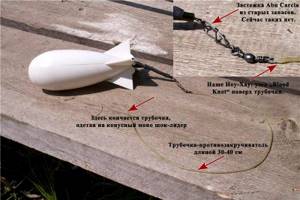
After measuring, you need to tie an additional segment according to the following scheme.
- The main line is wound onto the reel.
- An additional one is fixed with knots, it unwinds to the end of the rod and from there again to the reel.
- The excess leader is trimmed.
- Attachment equipment is installed.
Since you can tie the shock leader to the main fishing line directly while fishing, it is recommended to prepare all the components in advance. Beginning fishermen can do these steps at home. This is necessary to develop a skill. Additionally, you should check the strength of the fastening by making several casts in open areas.
In the video instructions, an experienced fisherman will explain the nuances of using a shock and clearly show the stages of tying:
Knots for fixing the shock leader: types and methods of knitting
The most popular types of knots among fishermen are:
- Clinch;
- Palomar;
- Albright;
- Bloody knot.
A type like Clinch is quite easy to knit and has good strength. Its main purpose is to tie hooks, but it is also a good option for making a shock leader. It is necessary to make a small loop at the end of the braid and attach the equipment to it with a Clinch. The resulting fastening must be well moistened with water, this will give it strength and will not deform the tackle.
Palomar is one of the most reliable knots, it is done in literally three steps:
- we form a regular loop and pass it through the eye;
- holding the eye in the middle of the loop, we knit a regular knot;
- We thread a swivel with a carabiner through the loop. Wet it and tighten it tightly.
To get an Albright , you need to make a loop from a medium-sized shock leader and pass braided or main fishing line through it. And gradually make 10 revolutions. After this, we pass one end of the braided cord through the loop, moisten it with water and tighten it.
And in order for all the fastening turns to lie evenly and fit well to each other when tightening, you need to pull all ends at the same time. This type is designed for heavy loads and provides a good casting range.
The bloody knot received such an unpleasant name because in tsarist times it was used as a punishment in the navy. The knot was attached to the end of the whip and the offending sailors were beaten with it.
Well suited for connecting lines of different diameters.
To get the perfect Bloody Knot you need to wrap one line around the other, make a few turns and thread it through the middle. If braid is used as a basis, then it is better to make 10 turns; 7 turns will be enough with fishing line. We wet it, tighten it and the knot is ready.
And in order for any type of knot to become smoother and collect less debris, it is better to glue it after tightening. A good solution would be regular waterproof superglue.
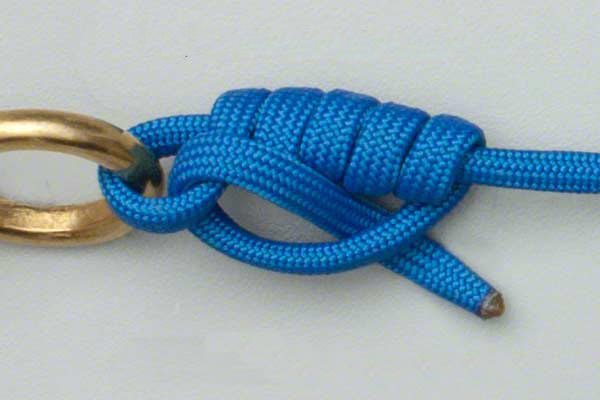
Carrot knot for shock leader
How to tie a shock leader to the main line

The main problem of mating is the formation of a knot. The smaller the unit, the easier it is to use the equipment. The fisherman must pay special attention to this element. Therefore, it is better to carry out the connection at home, in an environment that allows you not only to create a neat knitting, but also to practice compliance with the nuances of streamlining by gluing the turns and creating a close homogeneous structure of the thread with the ends of the knot cut. The practice of feederists has shown that three types of nodes are most effective for making connections, which we will consider in more detail in the next part of the material.
Shock leader for feeder: characteristics, application features
The shock leader is an integral part of the feeder gear; it is a piece of dense fishing line 10–15 m long. If you plan to fish for fish of the carp family, the shock leader can prevent unexpected breaks in the gear. This part of the fishing equipment takes on the maximum load when casting. Therefore, you can easily use heavy weights (from 80 - 100 g).
In addition, if the maximum carrying capacity of the fishing line is on average 3–4 kg, then the shock leader has about 11–12 kg. And this does not affect the casting distance in any way.
The use of this part of the feeder tackle reduces the level of resistance of the main line when immersed in water. Allows the use of fishing line of small diameters.
The advantages of use include:
- Prevents damage to fingers when casting;
- Able to withstand heavy loads;
- Due to its increased strength, it is resistant to abrasion;
- It becomes possible to frequently replace the main line, reducing its diameter;
- The consumption of braid is reduced since the equipment can be attached directly to the shock leader;
- Even with the maximum tension of the rod, there is no need to worry about the tackle breaking.
There are also disadvantages of use:
- Reduced casting distance. This is facilitated by the knot with which the shock leader is connected to the main line, due to its low permeability through the tip rings;
- Particles of grass or clay getting into the knot;
- If fishing on a fast-moving reservoir, the windage of the fishing line increases significantly;
- The sensitivity level of the gear may decrease.
